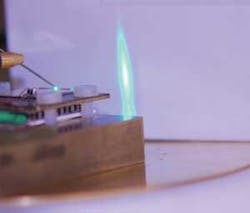SEMICONDUCTOR LASERS: Laser diodes are getting the green light

Laser diodes excel at emitting blue or red light; it’s in the green that they falter. While miniature diode-pumped solid-state lasers can be combined with nonlinear crystals to form, for example, green laser pointers, such emitters are larger and far more expensive than their red counterparts.
The creation of a cheap, reliable green laser diode would not only make for tiny green pointers—it would also lead to truly miniature laser projectors that could be integrated into cell phones and other small, low-power devices. Corporate and university research groups are hotly pursuing this goal, and in more ways than one.
The InGaN approach
One route to a green wavelength is to take the current blue-diode technology and push it beyond its limits; this means working with indium gallium arsenide (InGaN) as a semiconductor material. While this approach hasn’t yet resulted in a pure green laser diode, blue-green versions are already working well. For example, researchers at Osram (Regensburg, Germany) have grown indium-rich InGaN quantum wells with very few defects, resulting in electrically driven room-temperature lasers that produce peak output powers of up to 70 mW under pulsed operation.1
Fabricated on commercial c-plane GaN substrates, the gain-guided lasers have mirror coatings with reflectivities of 50% and 95%. The lasers emit at 498 nm and have a threshold current density of 6.2 kA/cm2 at 25°C, a threshold voltage of 6.0 V, and a slope efficiency of 650 mW/A. The researchers foresee a further reduction in the threshold current density, allowing a shift to even longer wavelengths without changing the indium content of the quantum wells.
In another effort, engineers at ROHM (Kyoto, Japan) created nonpolar m-plane electrically pumped InGaN multiple-quantum-well laser diodes that emit a maximum of 15 mW continuous-wave at 499.8 nm.2 Two versions of the lasers were made that have front-mirror-facet reflectivities of 70% and 97%, respectively (the rear facets of both had reflectivities of 99%). The emission peak and output power for the laser with a 97% front facet are 499.8 nm and 15 mW; for the laser with the 70% front facet, the values are 492.8 nm and 30 mW. Both have a spectrum with many longitudinal modes over a range of 1 to 2 nm, and a single-transverse-mode near-field pattern. The longer-wavelength laser has a 3.1 kA/cm2 threshold current density, a 5.9 V threshold voltage, and a slope efficiency of 50 mW/A.
The emission wavelength of the lasers increases with increasing input of electrical power by 4.56 and 4.34 nm/W for the lasers with 70% and 97% front mirrors, respectively; the ROHM researchers say that stabilizing the lasers’ output wavelength will require increasing the slope efficiency or reducing the driving voltage.
The novel-materials approach
While green laser diodes fabricated of non-InGaN materials are further from practicality, researchers at Sophia University (Tokyo, Japan) have been working for years on lasers and LEDs based on different II-VI semiconductor compounds on indium phosphide (InP) substrates. Their latest device is a photopumped diode laser based on beryllium chalcogenide (BeZnSeTe) active layers and magnesium selenide/beryllium zinc telluride (MgSe)/(BeZnTe) superlattice cladding layers on InP; the laser emits a true-green 548 nm.3
The laser diode is pumped with 355 nm light from a pulsed frequency-tripled Nd:YAG laser at room temperature. For 5 ns pump pulses at a 20 Hz repetition rate, green laser light was emitted for excitation power densities of 76.6 kW/cm2 and above.
The researchers estimated the current density that would be required for electrical pumping of the BeZnSeTe active layer, basing their figures on a threshold carrier density calculated from the 76.6 kW/cm2 threshold excitation power density. They arrived at threshold current densities ranging from 0.22 to 0.73 kA/cm2, depending on what they assumed for the efficiency of carrier injection from the cladding into the active layer. They note that even the 0.73 kA/cm2 figure is comparable to the threshold current density for commercial red laser diodes, and is less than that for commercial blue laser diodes, showing the potential of BeZnSeTe as an active layer for green laser diodes.
REFERENCES
- D. Queren et al., Appl. Phys. Lett. 94, p. 081119 (2009).
- K. Okamoto et al., Appl. Phys. Lett. 94, p. 071105 (2009).
- I. Nomura et al., Appl. Phys. Lett. 94, p. 021104 (2009).
About the Author
John Wallace
Senior Technical Editor (1998-2022)
John Wallace was with Laser Focus World for nearly 25 years, retiring in late June 2022. He obtained a bachelor's degree in mechanical engineering and physics at Rutgers University and a master's in optical engineering at the University of Rochester. Before becoming an editor, John worked as an engineer at RCA, Exxon, Eastman Kodak, and GCA Corporation.
